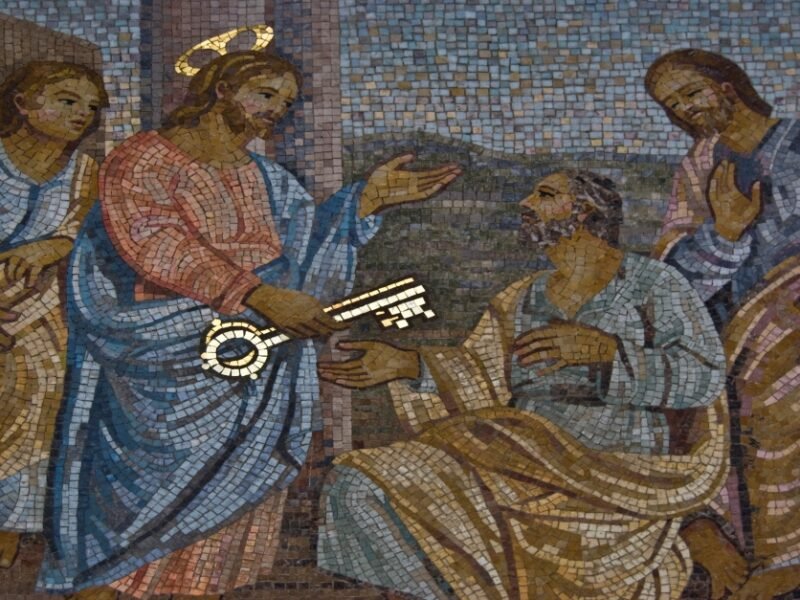The other day, I read a lovely book by Stephen Meawad, who teaches theology at Caldwell University. Titled Beyond Virtue Ethics (2023), this book argues that all too often, we treat ethics in isolation, as if it were either just a bunch of rules imposed on us, or else a matter of developing patterns of virtuous behavior. We disagree so sharply among ourselves about what the legal rules are or what makes for virtuous behavior that, for the most part, neither command ethics nor virtue ethics make for a proper moral framework.
Meawad makes the case that we need to treat ethics as a subset of spirituality. His book is all about the spiritual struggle of Christians and about eternal progress (epektasis) of the human person into the divine life—hence the subtitle of his book, A Contemporary Ethic of Ancient Spiritual Struggle. The virtue that Christians are concerned to bolster, therefore, is nothing less than God’s own character.
One of the spiritual struggles in the development of virtue is that of reading Scripture. Meawad devotes an entire chapter to sacred reading—lectio divina as it is often called. I much appreciate Meawad’s insistence that sacred reading is a spiritual struggle, one that aims to mature our moral life and, in the process, to unite us more deeply with God. I titled my book on the fourth-century mystical theologian Gregory of Nyssa Embodiment and Virtue, since Gregory thought of embodied human virtues (small-v) as participating in divine Virtue (capital-V). For Gregory, as for Meawad, the moral life is not anything different from the spiritual life, for the process of embodying virtue is at one and the same time the process of being deified.
The purpose of reading Scripture is to change or transfigure us. Many in the Christian tradition have distinguished four steps in this transfiguring sacred reading: reading (lectio), meditation (meditatio), prayer (oratio), and contemplation (contemplatio). Guigo II, in what is probably the best little book ever written on lectio divina, The Ladder of Monks, treats the four steps as distinct stages in the Christian life of anagogy—moving upward onto the ladder so as to participate in the divine life through spiritual reading. I typically recommend Guigo’s twelfth-century booklet to anyone wanting to familiarize himself with sacred reading. It is a short, readable explanation of what lectio divina is and how it functions.
Meawad maps the steps of sacred reading differently than Guigo, speaking of three steps: willingness, embodiment, and immersion. The first step is a willing and vulnerable submission to the Christ of Scripture and to its communal reading in the church. In the second step, that of embodiment, the words of Scripture begin to shape our character as we prayerfully aim to be transformed and assimilated to God. The final step, that of immersion, provides us with the “mind of Christ” (1 Cor. 2:16), such that we are united with him and our entire being—body and soul—exudes his peace and love.
I came to lectio divina in a rather roundabout fashion. I had long been interested in patristic exegesis. I saw in the fathers a reading of Scripture that focuses on Christ as the sacramental reality (res) that the external words of the biblical text (sacramentum) make present. Saint Irenaeus famously used the little parable of the treasure hidden in the field (Matt. 13:44) to make this same point. Christ, the second-century bishop of Lyons insisted, is the treasure that we ought to dig up from the field (or the Scriptures). Irenaeus maintained, therefore, that “when [the Law] is read by the Christians, it is a treasure, hid indeed in a field, but brought to light by the cross of Christ” (Against Heresies 4.26.1).
When I encountered the practice of lectio divina—much too late in my career—I realized that this practice, embraced in both East and West from the time of Origen, was basically a way of digging up the treasure. By moving through the process all the way from reading (Guigo’s first step) to contemplation upon God (Guigo’s last step), we are simply digging up the treasure. We look for Christ and encounter in him the joyful happiness of God.
The link between sacred reading and the spiritual life is clear from the way that Guigo maps the four steps of sacred reading onto the four levels of meaning commonly distinguished in the Middle Ages: reading has to do with the literal or historical meaning of the text. Meditation takes us to its allegorical meaning, where we encounter Christ and the church. Prayer confronts us with the need for transformation and hence offers us the tropological or moral meaning. And in contemplation, we arrive at the heavenly presence of God’s own glory, which is reflected in the anagogical or eschatological meaning of the text. The four levels of biblical meaning are like the four steps of spiritual ascent, which we climb through the process of lectio divina.
My book on lectio divina, Pierced by Love, takes the reader to the writings of spiritual writers throughout the Great Tradition. But I focus especially on twelfth-century monastic writers, since they intently and methodically read Scripture as a liber experientiae (book of experience). This Latin expression, coined by Bernard of Clairvaux, highlighted these spiritual writers’ focus on one’s personal appropriation of the biblical text, with a view to encountering Christ. Bernard puts it this way in one of his sermons: “Today we read the book of experience (libro experientiae). Let us turn to ourselves and let each of us search his own conscience about what is said. I want to investigate whether it has been given to any of you to say, ‘Let him kiss me with the kiss of his mouth’ (Sg 1:1).” Practitioners of lectio divina simply don’t let us get away with keeping the Bible at a distance by applying a hermeneutical historical method borrowed from the hard sciences.
Come to think of it, if sacred reading takes us through each of the four medieval levels of meaning (historical, allegorical, tropological, and anagogical), and if these four levels make for a wholesome interpretation of the text, then sacred reading is what we naturally or typically do, whenever we read the Bible. Practising lectio divina is simply reading the Bible in line with its divinely given telos or purpose.
God has given us the Scriptures primarily to help us embark upon our spiritual struggle to become divine. Surely, then, it cannot be right for biblical scholars to keep reading the Bible as if they were historians rather than theologians. True biblical scholars (and true theologians!) are mystagogues—people who have been caught up in paradise, who have heard there unspeakable words (2 Cor. 12:5), and who now, like Moses and Paul, come down the mountain and share with others something of the divine glory that they have encountered. True biblical exegesis interprets the text with a view to our ultimate end, the contemplation of God.







'Lectio Divina as True Biblical Exegesis' has no comments
Be the first to comment this post!